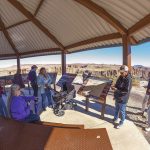
50 Years Ago: Work on NCC’s new home begins
This was an important week for Navajo Community College. Forty years ago this week construction crews began preparing a section of land near Tsaile Lake to become the new home of the college.
For the previous year, the college had been holding classes at the BIA’s boarding school in Many Farms, Arizona, which everyone admitted had not been an ideal situation. Dormitory and classroom space were limited so the college had been restrictive in how many students could be enrolled.
But the college had $4.1 million in grants from the federal and tribal governments and was ready to move on to its next phase.
The plan was to start small with construction of dormitories to house 300 students, a classroom building that would serve 500 students and a building for vocational studies. Smaller buildings would house administrative staff. The college planned to use part of the money to build housing for teachers and staff.
Work on the buildings was expected to start the following spring with completion expected in 1971.
The big question was if all of this could be done with just $4.1 million, and the answer to that was no.
College officials said they planned to seek a couple of million more dollars in 1970 and 1971 to complete the planned construction.
“The money will be there,” said Bob Roessell, the college’s chancellor. “All we have to do is seek it out.”
In other news, the U.S. Department of Housing and Urban Development sent a stern letter to the tribe to do something about the increasing number of Navajos living in low-income housing who were refusing to pay their rent.
This was a problem that had been going on for years as a group of tenants living in Navajo Housing Authority houses had refused to pay saying they couldn’t afford the payments, which, in most cases, were between $50 and $100 a month.
Part of the problem seemed to be that if the rents were not paid nothing would happen since there were no tribal laws that give NHA the power to evict anyone. Some families owed thousands of dollars in back rent.
No one had ever been evicted by NHA for failure to pay rent and NHA officials had been urging the tribe to pass laws to handle this situation or face the possibility of other renters joining the group of some 20 families who were refusing to make payments.
Since the rental payments were used to maintain the buildings, NHA officials were worried that more families would take advantage of the lack of eviction laws and this would make it impossible for the agency to get the funds necessary to maintain the buildings.
NHA officials said that when the families signed their leases, there was a clause in the contracts that allowed for eviction for non-payment but when they sought help from Navajo Police to help them enforce that provision, police declined, citing the lack of any tribal law giving them that authority.
HUD officials had told the tribe that no further housing funds would be approved until this matter was resolved, so a special meeting of the Navajo Tribal Council had been set for later this month to pass a tribal eviction law.
When it came before Council, there was a lot of concern for the families who were behind in their payments and who would be evicted during the Christmas holidays. But the law was written to allow families to stay if they began paying their current rental payments and agreed to set up a payment plan to get current within a year, The new law was approved by a vote of 40 to 1.
The Council agreed to take up another matter that had been lingering for years – a retirement plan for tribal employees. The tribe had no retirement program because it had not been seen as a problem.
Up until the 50s, the tribal government consisted basically of an administrative staff and a few clerical helpers.
But that all changed when the tribe started getting millions of dollars in royalties for oil and gas and uranium. The government exploded and by 1969 numbered more than a thousand people, some of whom had been working for the tribe for a decade or more.
That had resulted in demands for a retirement program and Council finally agreed to address these concerns at that special meeting.
The good news for tribal employees was that Council did discuss the problem. The bad news was that the delegates could not come up with a plan because no one knew how much it would cost the tribe to set it up.
The Council delegates had no problem setting aside money during the budget sessions for future retirement but what about all of the employees who were waiting to retire once a retirement plan was approved?
Council delegates said they needed time to do a financial study and tabled the matter for three months.
The Navajo Times would take up the employees’ cause in the ensuing months and urge the Council to approve a retirement plan before the upcoming election or face the possibility of being voted out of office.








 Highway 264,
Highway 264, I-40, WB @ Winslow
I-40, WB @ Winslow